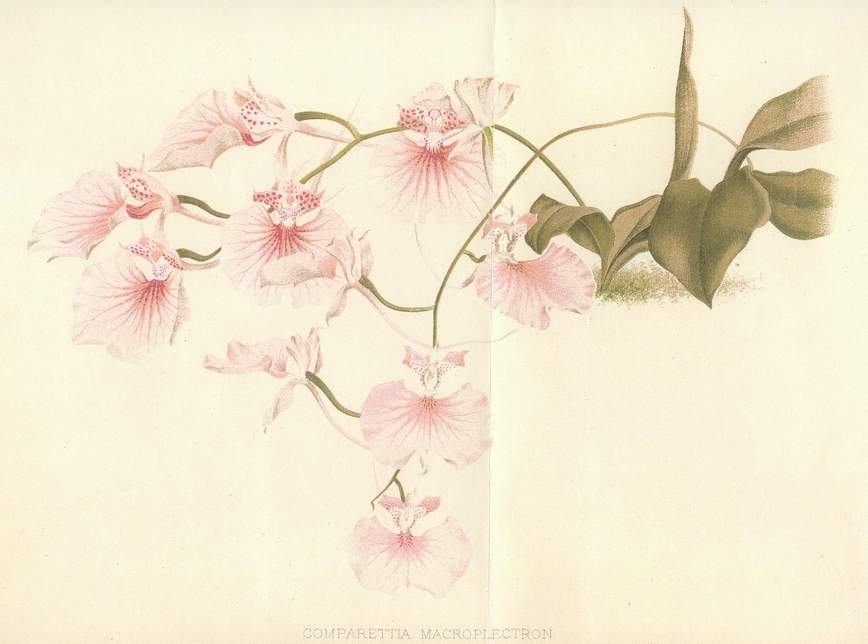
numérisation : gracieuseté de Peter Fowler, UK / Thanks !
Comparettia macroplectron Rchb. f. & Triana
| publié dans : |
Gardener's Chronicle & Agricultural Gazette 1: 398. 1877-78. |
bibliographie sur l'espèce
|
Bockemuhl_L et K Senghas, 1986, Comparettia macroplectron Rchb. f. & Triana 1878, Orchidee, 37(5): pages centrales, détachables (2p.). Foster, R. C., 1958, A catalogue of the ferns and flowering plants of Bolivia, Contributions from the Gray Herbarium of Harvard University, 184: 1-223. Sheehan, Tom et Marion, 1977, Orchid Genera, Illustrated - 58 - Comparettia, American Orchid Society Bulletin, 46 (9), p. 805. Teuscher, Henry, 1976, Collector's Item / Scelochilus, Neokoehleria and Comparettia, American Orchid Society Bulletin, 45 (7), pp. 597-602. Williams, Benjamin Samuel, The Orchid Grower's Manual, 1894, pp. 211-212. |
distribution
| Même si certaines sources indiquent
que la distribution de Comparettia macroplectron s'étendrait à
l'Équateur, aucune donnée de collecte fiable ne permet de prouver cette
hypothèse.À ce jour, la distribution connue et confirmée de cette
espèce est limitée à deux départements de Colombie, Boyacá
et Cundinarmarca.
Dans un courriel (20 avril 2005), Pedro Ortiz Valdivieso, indique : "En Colombia ciertamente es común (aún hoy día lo es) en la vertiente oriental de la Cordillera Oriental (Departamentos de Cundinamarca y Boyacá), alturas entre 1300 y 2300 m". Cette distribution était déjà mentionnée dans l'ouvrage de l'auteur, publié en 1982, Orquídeas ornementales de Colombia (p. 143). En ce qui a trait à la possible distribution équatorienne, Leonore Bockemuhl et K Senghas, dans un article publié dans Die Orchidee, en1986, "Comparettia macroplectron Rchb. f. & Triana 1878" 37(5): pages centrales, détachables (2p.) écrivent : "Herr Cl. HORICH/Costa Rica teilte mir mit, daß er die gleiche Spezies sogar im Norden Ecuadors in der Nähe der Stadt Pichincha gesehen habe. Leider wurde seine Angabe aus Ecuador weder bestätigt noche dementiert,d.h. ich bekam auf diesbezüggliche Nachfragen keine Antwort." (p. 259) [ "Monsieur Cl. Horich, depuis le Costa Rica, m'a indiqué qu'il avait également vu la même espèce au nord de l'Équateur, près de la ville de Pichincha. Malheureusement, sa présence dans cette région n'a pas été confirmée ni démentie - c'est-à-dire, je n'ai pas obtenu de réponse à des requêtes additionnelles à ce sujet." (ma traduction)] Pour sa part, Charles Marden Fitch mentionne, dans un article publié dans l'American Orchid Society Bulletin : "The road between Bogotá and Tunja, capital of Boyacá, is excellent so it is an easy day's jaunt to Machetá [~2000 m], a small town midway between the two cities [en empruntant une route secondaire vers l'est]. In this area one December I found ... Comparettia macroplectron ... [which] grow[s] abundantly in this region." [36 (4) - April 1967, p. 320]Quant à elle, Irene Bock, dans un article publié en 1986 dans Die Orchidee, "Revision der Gattung Comparettia Poepp. & Endl.: Teil 3" [37 (6)], indique qu'elle a trouvé l'espèce à l'ouest de la Colombie. |
|
|
|
source de l'illustration : The Garden, XXX, 1883, t. 385
numérisation : gracieuseté de Peter Fowler, UK / Thanks ! |
|
source de l'illustration : Curtis's Botanical Magazine, Vol. 109 series 3, 1883, planche 6679.
numérisation : gracieuseté de Peter Fowler, UK / Thanks ! |
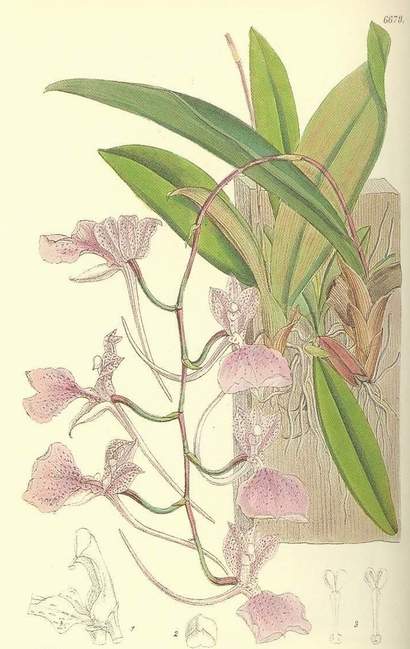
|
textes d'archives
| " PL.DCLXIV
COMPARETTIA MACROPLECTRON RCHB. F. & TR. COMPARETTIA.
Vide Lindenia, vol. II, p. 30.
Comparettia macroplectron was discovered in 1878 in New Granada by the well-known Botanist JOSÉ TRIANA. In a short note in The Gardeners' Chronicle for October of that same year, it was referred to by REICHENBACH as "a very beautiful thing". That same author described it in much more detail in that same journal in March of the following year. |
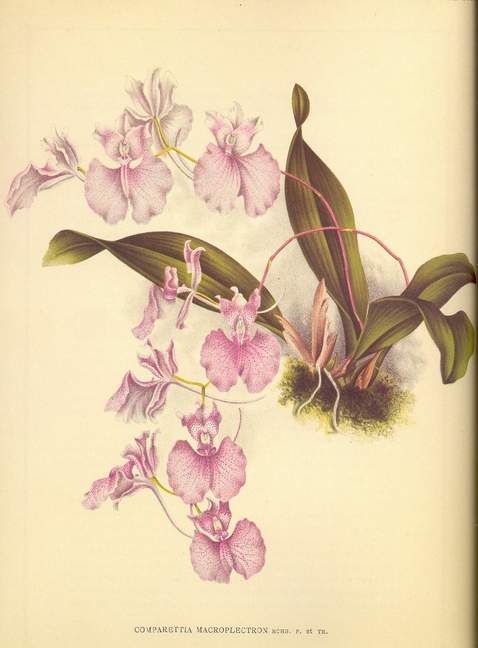
|
REICHENBACH wrote :
source du texte et de l'image : Lindenia. "C. Macroplectron.
source : .Veitch, .James, A Manual of Orchidaceous Plants, Part IX, 1893, pp. 166-167. références et numérisation de ces textes et de l'illustration / references and scans of the texts and illustration : kindly provided by Peter Fowler, UK -- Merci / Thanks ! |
|
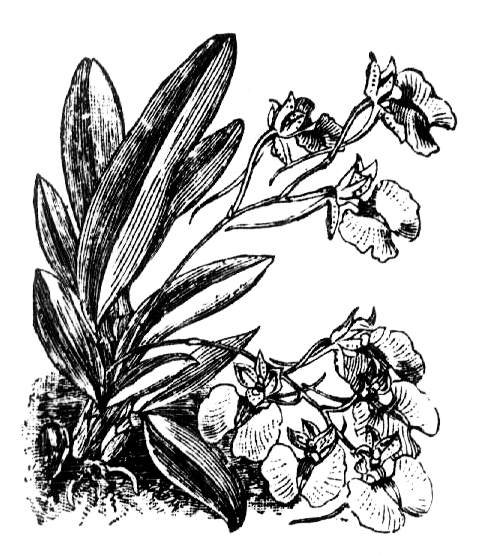
|
source de l'illustration : Williams, Benjamin Samuel, The Orchid Grower's Manual, containing descriptions of the best species and varieties of orchidaceous plants in cultivation together with notices of their times of flowering, and most approved modes of treatment ; also, plain and practical instructions relating to the general culture of orchids ; and remarks on the heat, moisture, soil, seasons of growth and of rest best suited to the several species and varieties, 1894, p. 212. |
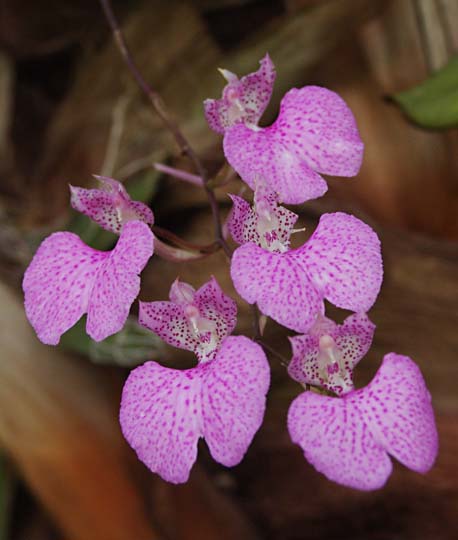
|
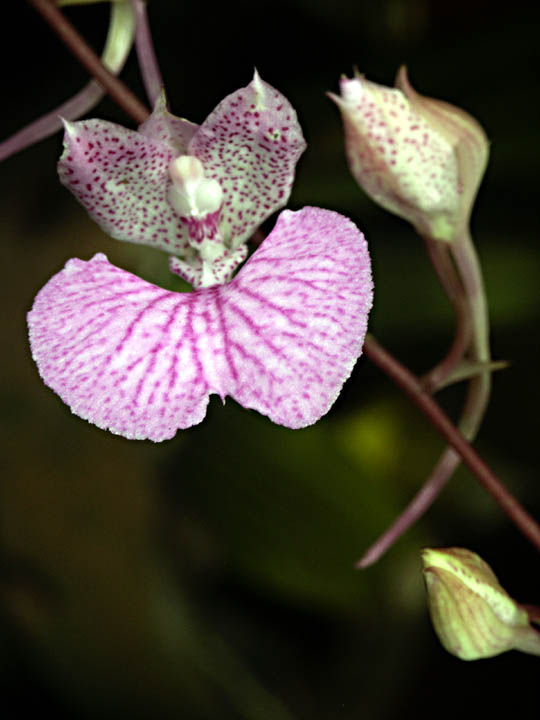
|
|
|
|
||
| photos : plantes collectées et cultivées par | Guillermo Angulo
Bogotá, Colombia |
|
|
Gracias / Grazie / Merci ! |
||
|
"Ahora
en semana santa ... me dedique a la cacería de la Comparettia
macroplectron... Encontré un especimen con 367 flores, y
algunas de unos colores más oscuros, muy bellas. Otras de flores muy
grandes."
(communication personnelle - courriel de Guillermo Angulo, 26 mars 2005) |
Ci-haut, dans la rue principale de Fómeque (Cundinamarca), tenant un spécimen de l'espèce: Crisanto Gutiérrez. Ce dernier est le jardinier responsable de la collection d'orchidées de Guillermo Angulo qui sont cultivées à La Unión (Cundinarmaca), dans un jardin surnommé Orquidiócesis de Tegualda. Crisanto et son épouse, Hilda Gómez, participent toujours aux randonnées de collecte d'orchidées de Guillermo qui vit dans la capitale, Bogotá. |
|
|
espèce, in situ |
|
|
|
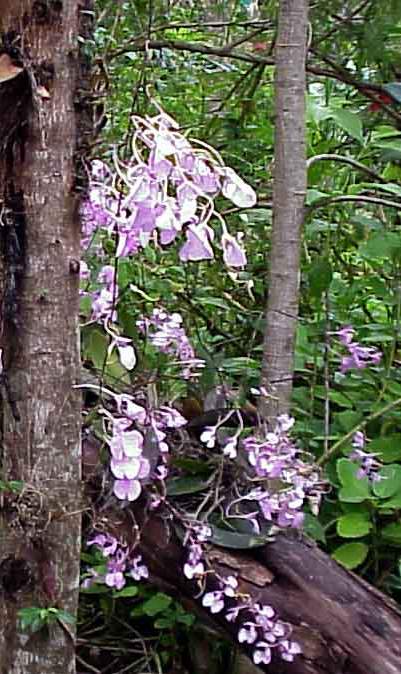
|
| "se
encuentra... en ... el oriente de Cundinamarca: en (Choachí, La
Unión, Fómeque, Ubaque y Cáqueza,
sobre la cordillera Oriental de los Andes, a alturas que van desde los 1
500 msnm hasta los 2 500. Pero donde se siente más cómoda es
alrededor de los 1 700.
Su árbol preferido es el guayabo, (Psidium guajaba), que es de tronco extremadamente liso. ... Los ejemplares más vigorosos se encuentran sobre otros árboles, como el arrayán (Myrtus foliosa), con muchas hojas y corteza rugosa, y con menos luz de la que encuentran en los guayabos." (communication personnelle - courriel de Guillermo Angulo, 7 août 2005) |
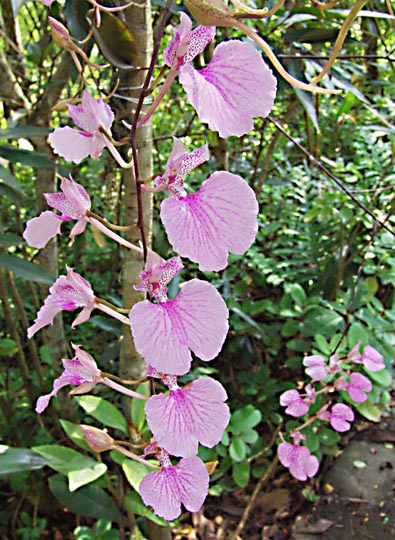
|